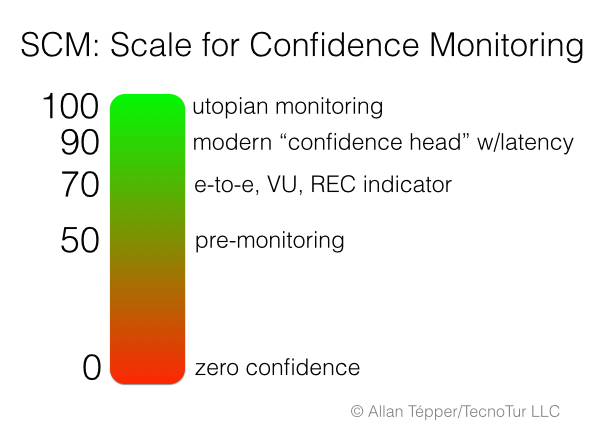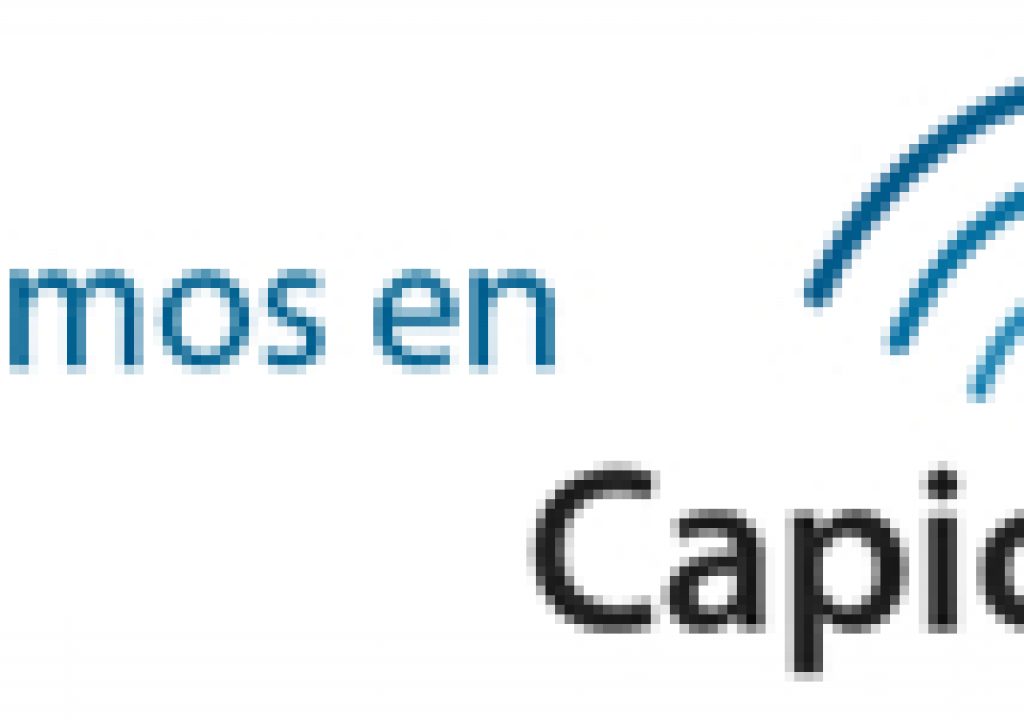In a recent article called Confidence: What it means in audio/video production, I defined the concept of confidence in monitoring. Having done that, the purpose of this article is to establish a tough scale to apply to both audio/video devices and for systems. This new standard SCM (Standard for Confidence Monitoring) takes into account multiple factors including purposes and goals, noticeable latency, visual indicators, pre-monitoring, e-to-e monitoring, and the modern equivalent of a confidence head for today’s solid state recording.

In a recent article called Confidence: What it means in audio/video production, I defined the concept of confidence in monitoring. Having done that, the purpose of this article is to establish a tough scale to apply to both audio/video devices and for systems. This new standard SCM (Scale for Confidence Monitoring) takes into account multiple factors including purposes and goals, noticeable latency, visual indicators, pre-monitoring, e-to-e monitoring, and the modern equivalent of a confidence head for today’s solid state recording.
Link to prior article
Here is a link to the prior article Confidence: What it means in audio/video production, where some terms used in this article were first defined.
An abbreviation for our Scale for Confidence Monitoring
At least in the English language, I see no better abbreviation for our Scale for Confidence Monitoring than SCM, despite the following preexisting uses of this acronym:
Organizations
- SCM Corporation, an American typewriter and calculator manufacturer
- SCM Holdings, a holding company owned by Ukrainian tycoon Rinat Akhmetov
- SCM Press, a UK-based academic publisher of theology
- Student Christian Movement of the United Kingdom
- Supply chain management
- Student Christian Movement, members of the World Student Christian Federation
Science and technology
- Scanning capacitance microscopy, a mode of scanning probe microscopy
- Schwarz, Corradi, Melnick astronomical catalogue
- Standard cubic meter, a unit of natural gas measurement
- Sternocleidomastoid muscle
- Subcarrier multiplexing, a multiplexing method used in optical communication systems
Computing
- SCM (Scheme implementation), a free software Scheme implementation
- Service Control Manager, a component of Microsoft Windows operating systems
- Software configuration management
- Source control management or source code management, the management of documents, source code, or other data in a computing project
Other uses
- Set, Complete, Meteorological, a Signal Corps Radio term
- Squadron Corporal Major, a warrant officer appointment in the British Household Cavalry
- STAR Chinese Movies, a Chinese movies channel owned by Fox International Channels
- Sweetened condensed milk
Evidently, none of the above examples had any exclusivity of the SCM abbreviation, so we are certainly not changing that fact by using it ourselves
100 rating on the SCM: the confidence monitoring utopia
Although the confidence monitoring utopia may not yet be available with current technology, it should absolutely be our ultimate goal when establishing our standard Scale for Confidence Monitoring. At the utopian 100 SCM, we would have zero latency monitoring of the modern equivalent of the confidence head, where we actually get to hear —and/or see— the result after the recording has been successfully taken place and immediately played back.
0 (zero) rating on the SCM: no confidence at all
Zero (o) represents no confidence at all: no headphone output for audio; no VU or similar audio indication; no viewfinder (like the Hasselblad cameras used in the Apollo 11 mission, according to the public information released by NASA and Hasselblad).
When we have zero confidence, we are shooting or recording without any assurance at all that we are recording, aimed properly, framed properly, in focus, or whether or not we are getting pops as a result of sibilance.
50 rating on the SCM: some pre-monitoring
With a 50 rating on the SCM, we get some pre-monitoring, be it:
- A latency-free headphone output on an audio mixer or digital microphone, i.e. the AT2005USB mcrophone from Audio Technica (reviewed in several of my articles and ebooks) or the NT-USB from RØDE (reviewed here).
- A multicolored diode that indicates the presence of power and relative audio level, as in the case of the iRig Mic HD digital microphone from IK MULTIMEDIA (reviewed here), the Android version iRig Mic HD-A (reviewed here), or the iRig PRO preamp/A-to-D converter (reviewed here) from the same manufacturer.
- A viewfinder on a camera.
When we have a 50 rating on the SCM, we know that the microphone or camera has power, is properly aimed/framed, whether or not we have pops resulting to sibilance, and whether or not the image is in focus. However, we have no guaranty that the signal is being recorded at all, let alone properly.
75 rating on the SCM: The VU or e-to-e output of a recorder or camcorder, with REC indication
- The inboard VU or similar meter on a recorder or camcorder, together with a recording indicator and/or advancement of a counter.
- The inboard viewfinder together with a recording light or advancement of a counter.
- The headphone or video output of the e-to-e (electronics-to-electronics) signal, as explained in the original article, albeit with latency, as in the case of a NewTek TriCaster or an audio recording software that allows monitoring with latency due to hardware limitations.
In addition to everything that we get with a 50 rating as indicated above, with a 75 rating on the SCM, we also get more confidence that the signal is actually reaching the recorder, and a higher notion that a recording is actually taking place due to the recording light or advancement of a counter. However, it is still possible that a malfunction might prevent the recording from taking place, due to any potential failure in the recorder or recording medium.
90 rating on the SCM: The equivalent of a confidence head output, although with latency

Although there is up to 12 seconds of latency, the 702 portable audio recorder from Sound Devices essentially offers the equivalent of a modern confidence head, for us to be absolutely sure that the recording took place properly. It currently costs US$2,049.
- The headphone output or video output of the immediate playback of the signal just recorded, despite possible latency/delay, as in the case of the 702 from Sound Devices, as explained in the original article.
- The signal as it returns from the air (in the case of an over-the-air broadcast) or as received back from the Internet (in the case of a live webcast).
Graphic credit for this article
The Confidence Level graphic by Vic used in the prior article (and by reference in this one) is used under a Creative Commons CC by 2.0 license. I created the SCM graphic for this article.
Conclusions for SCM version 1.0
As indicated in this article, the SCM can be applied to:
- Capture components, like digital microphones, preamps/A-to-D converters, and cameras
- Mixers, recorders or computers which act as recorders
- Complete systems
In the case of a complete system, i.e. microphones which feed a preamp/A-to-D converter which feeds a computer… or a camera feeding a recorder, the SCM rating of each can blend to give us a systematic SCM rating. For example, a digital microphone with only a SCM 50 rating, when combined with a computer with recording software that on its own offers a 75 rating via its meter and recording indication can then achieve a systematic rating of a higher number like 80, especially if you want to avoid the latency and therefore prefer to monitor from the mic or hardware interface which offers latency-free monitoring, but can at least see the meter and recording indications on screen.
This article represents my implementation of SCM version 1.0. I may need to revise it in the future, either due to my own evolution, and/or from suggestions from readers. In the meantime, I’ll be using SCM version 1.0 to rate new devices and systems.
Upcoming articles, reviews, and books
Stand by for upcoming articles, reviews, and books. Sign up to my free mailing list by clicking here.
Si deseas suscribirte a mi lista en castellano, visita aquí. Si prefieres, puedes suscribirte a ambas listas (castellano e inglés).
Books, consulting, articles, seminars & audio programs
Contact Allan Tépper for consulting, or find a full listing of his books, articles and upcoming seminars and webinars at AllanTepper.com. Listen to his CapicúaFM program at CapicúaFM.com in iTunes or Stitcher.
My latest book (paperback + ebook)

My most recent book is available in two languages, and in paperback as well as an ebook. The ebook format is Kindle, but even if you don’t have a Kindle device, you can read Kindle books on many other devices using a free Kindle app. That includes iPad, Android tablets, Mac computers, and Windows computers. Although generally speaking, Kindle books are readable on smartphones like Androids and iPhones, I don’t recommend it for this particular book since it contains both color photos and color comparison charts. The ebook is also DRM-free.
In English, it’s The Castilian Conspiracy. Click here and you will be automatically sent to the closest Amazon book page to you based upon your IP address. Or request ISBN–10: 1456310232 or ISBN–13: 978–1456310233 in your favorite local bookstore.
En castellano, se llama La conspiración del castellano. Haz clic aquí para llegar al instante a la página del libro correspondiente a tu zona y moneda en Amazon, según tu dirección IP. De lo contrario, solicítalo en tu librería preferida con los ISBN–10: 1492783390 ó el ISBN–13: 978–1492783398.
FTC disclosure
No manufacturer is specifically paying Allan Tépper or TecnoTur LLC to write this article or the mentioned books. Some of the other manufacturers listed above have contracted Tépper and/or TecnoTur LLC to carry out consulting and/or translations/localizations/transcreations. Many of the manufacturers listed above have sent Allan Tépper review units. So far, none of the manufacturers listed above is/are sponsors of the TecnoTur programs, although they are welcome to do so, and some are, may be (or may have been) sponsors of ProVideo Coalition magazine. Some links to third parties listed in this article and/or on this web page may indirectly benefit TecnoTur LLC via affiliate programs.
Copyright and use of this article
The articles contained in the TecnoTur channel in ProVideo Coalition magazine are copyright Allan Tépper/TecnoTur LLC, except where otherwise attributed. Unauthorized use is prohibited without prior approval, except for short quotes which link back to this page, which are encouraged!

Filmtools
Filmmakers go-to destination for pre-production, production & post production equipment!
Shop Now
















